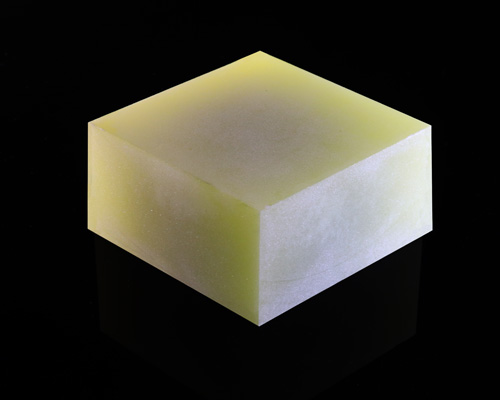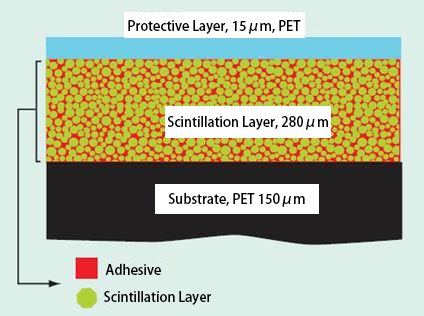GOS Ceramics: A Comprehensive Guide
Introduction:
GOS ceramics, short for Gadolinium Oxysulfide, have emerged as a cutting-edge material with remarkable properties. This article describes the composition of GOS ceramics, introduces the variants of GOS ceramics (GOS:Pr and GOS:Tb), explores the applications of GOS ceramics in CT and X-ray imaging, and sheds light on the innovative GOS scintillation screen.

FIgure 1. GOS ceramic sample from Shalom EO
What Are GOS Ceramics Made of?
GOS Ceramics, or Gadolinium Oxysulfide ceramics, are primarily composed of the chemical compound Gadolinium Oxysulfide (Gd2O2S). Gadolinium is a rare earth element, and in its oxysulfide form, it exhibits unique luminescent properties that make it suitable for various applications, especially in the field of scintillation screens for imaging technologies.
GOS Ceramics belongs to a hexagonal system structure (space group: P3− ml; lattice parameters: a = b = 0.3851 nm and c = 0.6664 nm) with trigonal symmetry. Each gadolinium ion is coordinated by four oxygen atoms and three sulfur atoms in a non-inversion symmetric arrangement.
The composition may also include specific activators to enhance the luminescence and performance of GOS ceramics. For example, GOS:Pr refers to GOS ceramics activated with Praseodymium, and GOS:Tb refers to GOS ceramics activated with Terbium. These activators play a crucial role in tailoring the properties of GOS ceramics for specific applications, such as medical imaging.
In summary, GOS Ceramics are a promising scintillation material, with its high density and and high effective atomic number of Gd leading to a high interaction probability for X-ray radiation. their properties can be further modified by incorporating specific activators to meet the requirements of different applications.
The Features of GOS Ceramics:
Solid-state Gd2O2S (GOS) has excellent chemical and physical characteristics, such as high melting point (2070 ◦C), high density (7.43 g/cm3), high X-ray attenuation coefficient (~52 cm−1 at 70 keV), wide band gap (4.6–4.8 eV), favorable chemical durability, low phonon energy, low crystal symmetry, and low toxicity, which make it a promising host material for luminescence and scintillation applications.GOS ceramics, or Gadolinium Oxysulfide ceramics, exhibit several features that make them valuable in various applications, in particular in imaging technologies. GOS Ceramics and their variants doped with rare earth elements feature high light output and low afterglow, which are ideal for a scintillator material.
GOS:Pr and GOS:Tb Variants:
The incorporation of activators in GOS ceramics introduces unique characteristics, making it a versatile choice for different applications. GOS:Pr and GOS:Tb refer to specific variants of GOS ceramics that are activated with different rare earth elements—Praseodymium (Pr) and Terbium (Tb). These activators are attractive candidates for modifying the properties of Gadolinium Oxysulfide (GOS) ceramics to suit specific applications, particularly in the realm of scintillation screens for imaging technologies.
GOS:Pr (Gadolinium Oxysulfide activated with Praseodymium):
Praseodymium is a rare earth element that, when incorporated into GOS ceramics, imparts unique luminescent properties. When incorporated into the GOS matrix, Pr activates the material, influencing its response to incident radiation. The green-emitting GOS:Tb phosphor exhibits a high brightness and a high luminous efficiency and is applied in television screens, cathode ray tubes, and X-ray intensifying screens. GOS:Pr finds applications in fields such as medical imaging, where the luminescent properties of the material contribute to the development of high-performance scintillation screens. These screens are excellent for capturing and converting X-rays or other radiation into visible light for imaging purposes. The Pr3+-activated GOS ceramic is an effective ceramic scintillation material for high-quality imaging applications owing to its high X-ray conversion efficiency, strong stopping power for the incident X-ray, short lifetime, fast afterglow, high chemical stability, and good emission, matching with the high sensitivity of silicon photodiodes.
GOS:Tb (Gadolinium Oxysulfide activated with Terbium):
Terbium is another rare earth element used as an activator in GOS ceramics. GOS:Tb is known for its distinct luminescence and sensitivity properties. It emits wavelengths between 382-622 nm, with the emission peak positioned at 545nm. It is also an excellent green phosphor in projection CRTs. The addition of Tb to GOS ceramics contributes to the overall efficiency and performance of the material, making it well-suited for certain applications. However, the drawback of introducing Tb into GOS ceramics is that the efficiency will be reduced as temperature rises.
The variants of GOS ceramics are engineered to meet different requirements in terms of luminescence, sensitivity, and other relevant properties. Depending on the specific application, either GOS:Pr or GOS:Tb may be chosen to optimize the performance of the GOS ceramics, particularly in the development of scintillation screens for capturing and converting incident radiation into visible light in imaging technologies.
GOS Scintillation Screen:
One of the groundbreaking applications of GOS ceramics is the development of scintillation screens. These screens play a pivotal role in capturing and converting incident radiation into visible light, enabling high-resolution imaging in medical and industrial settings. The efficiency of GOS scintillation screens makes them indispensable in modern imaging technologies.
GOS scintillation screens are designed for high luminescent efficiency. The efficient conversion of incident radiation into visible light is crucial for producing clear and detailed images in medical and industrial imaging applications.
The use of GOS scintillation screens helps enhance the resolution of imaging devices. The conversion of radiation into visible light with high efficiency ensures that the resulting images have improved clarity and detail.
GOS scintillation screens, especially those activated with elements like Terbium (GOS:Tb), exhibit high sensitivity to low levels of radiation. This makes them suitable for applications where the detection of subtle variations in radiation intensity is critical.
GOS scintillation screens are versatile components used in a variety of imaging technologies beyond medical applications. They find applications in industrial inspections, non-destructive testing, and other fields where the conversion of radiation into visible light is essential for image capture.
The incorporation of GOS scintillation screens contributes to the ongoing innovation in imaging devices. Their ability to efficiently convert radiation into visible light makes them integral to the development of advanced and high-performance imaging systems.
The Manufacturing Technique of GOS Scintillation Screen
The Manufacturing Technique of GOS Scintillation Screen are stated as the following:
1. Using the coprecipitation method to produce the mixed powder of Gd2O3 and Tb2O3;
2. High-temperature sulfurization sintering forms GdSO grains;
3. Add adhesives, press the material into pieces, bound the pieces together with the PET substrates;
4. Stick a protective layer onto the light-exiting surface;
5. Gd2OS2:Tb, the emission peak is 550nm.

Figure 2. The diagram showing the structure of GOS scintillation screens
Applications of GOS Ceramics:
GOS ceramics, or Gadolinium Oxysulfide ceramics, find diverse applications across various industries due to their unique properties, including luminescence and sensitivity. Some notable applications of GOS ceramics include:
Medical Imaging:
GOS ceramics are extensively used in medical imaging technologies such as X-ray radiography and Computed Tomography (CT) scans. The luminescent properties of GOS enhance the conversion of X-ray photons into visible light, producing detailed and high-quality images for diagnostic purposes.
Industrial Radiography:
In industrial applications, GOS ceramics contribute to non-destructive testing through industrial radiography. The material's sensitivity to radiation allows for the detection of flaws or irregularities in materials without causing damage, making it valuable in quality control processes.
Security Imaging:
GOS ceramics play a role in security imaging systems, such as baggage screening at airports. The efficient conversion of radiation into visible light enables the creation of detailed images for security personnel to inspect and identify potential threats.
Nuclear Medicine:
GOS ceramics are utilized in nuclear medicine imaging techniques, where radioactive tracers are used to visualize and analyze the functioning of organs and tissues. The luminescent efficiency of GOS contributes to the detection and imaging of emitted radiation.
Gamma Cameras:
GOS ceramics are incorporated into gamma cameras used in medical imaging. These cameras detect gamma rays emitted by radiopharmaceuticals and convert them into visible light, allowing for the visualization of internal structures in the body.
Scientific Research:
GOS ceramics are employed in scientific research applications, particularly in experiments and studies involving radiation detection and imaging. Their versatility and sensitivity make them suitable for various research settings.
Dosimetry:
GOS ceramics are used in dosimetry applications, where they assist in measuring and monitoring radiation doses. This is crucial in fields such as radiation therapy in medicine and ensuring safe working environments in industries where radiation exposure is a concern.
Environmental Monitoring:
GOS ceramics can be applied in environmental monitoring systems to detect and measure radiation levels in the environment. This is essential for assessing potential hazards and ensuring the safety of ecosystems and communities.
Conclusion:
In conclusion, GOS ceramics, including GOS:Pr and GOS:Tb variants, represent a groundbreaking advancement in materials science. The incorporation of Gadolinium Oxysulfide with targeted activators opens up new possibilities in various applications, with a particular focus on CT and X-ray imaging. The development of GOS scintillation screens further highlights the versatility and efficiency of this innovative material in contributing to the evolution of imaging technologies. As we continue to unlock the potential of GOS ceramics, the future of high-performance, luminescent materials looks brighter than ever.
Hangzhou Shalom EO specializes in the manufacturing of GOS ceramics, including GOS:Tb, GOS:Pr, and GOS scintillation screens, where you could benefit from our expertise and cutting-edge technology. The products feature high light output, low afterglow, and are not harmful to the environment.
Tags: Unveiling the Capabilities of GOS Ceramics: A Comprehensive Guide

